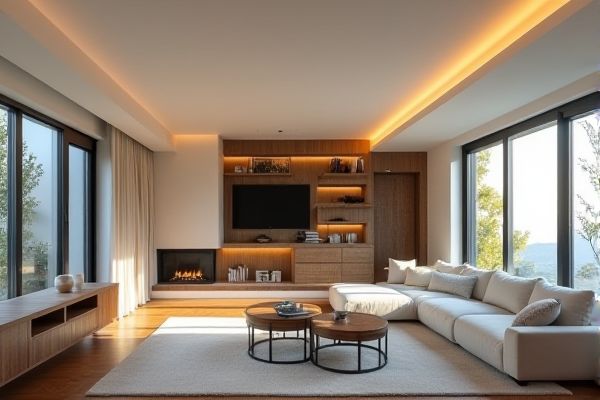
Choosing between an attic smart home hub and a main floor hub affects signal strength and device connectivity, with attic hubs often struggling due to structural interference while main floor hubs provide central access for most devices. Explore the article to understand which placement best enhances Your smart home network's efficiency.
Table of Comparison
| Feature | Attic Smart Home Hub | Main Floor Hub |
|---|---|---|
| Location | Attic | Main Floor |
| Signal Range | Lower due to attic placement | Wider, central coverage |
| Connectivity | Wi-Fi, Zigbee, Z-Wave | Wi-Fi, Zigbee, Z-Wave |
| Power Source | Hardwired or battery backup | Hardwired |
| Accessibility | Limited for maintenance | Easy access for updates |
| Interference | Possible signal interference from roof materials | Minimal interference |
| Optimal Use | Supplemental hub for upper floors | Primary hub for whole home control |
| Security | Standard hub security protocols | Standard hub security protocols |
Introduction: Choosing the Right Smart Home Hub Location
Placing a smart home hub in the attic offers extended range and centralized control over connected devices across multiple floors, ensuring seamless automation throughout your home. Main floor hubs provide easier access for maintenance and direct connectivity to frequently used devices, optimizing performance for living areas. Your choice depends on balancing signal reach with convenience and device density.
Key Differences: Attic vs Main Floor Hub Placement
Attic smart home hubs often provide better centralized control for multi-story homes by minimizing signal interference from walls and furniture, while main floor hubs offer easier access for setup and maintenance. The attic placement typically enhances overall Wi-Fi and Zigbee/Z-Wave signal range, improving connectivity for devices on all floors. Main floor hubs can offer faster troubleshooting and integration with directly connected home systems, but may experience reduced range compared to attic installations.
Signal Strength and Coverage Comparison
The attic smart home hub typically faces signal attenuation due to roof materials and elevation, which can reduce effective coverage compared to a main floor hub positioned centrally within the living space. Main floor hubs benefit from unobstructed line-of-sight to most devices, enhancing signal strength and minimizing dead zones across common areas. Optimal placement involves balancing centralized location with minimal structural interference to ensure robust smart device connectivity throughout the home.
Installation Challenges: Attic vs Main Floor
Installing a smart home hub in the attic presents challenges such as limited ventilation, difficult access, and potential signal interference from insulation materials, which may affect device performance. In contrast, main floor hubs typically offer easier installation with better airflow, accessibility for maintenance, and optimal signal distribution throughout living spaces. Assess your home's layout carefully to select the hub location that balances convenience and optimal connectivity for your smart devices.
Device Compatibility and Connectivity
The attic smart home hub often supports fewer compatible devices due to limited signal range and potential interference from insulation materials, impacting overall connectivity. Main floor hubs benefit from central placement within the typical living area, offering stronger, more consistent connections to a broader range of smart devices across multiple protocols such as Zigbee, Z-Wave, and Wi-Fi. Choosing a main floor hub enhances seamless integration and reduces latency, ensuring optimal device compatibility and network stability.
Temperature and Environmental Considerations
An attic smart home hub must be designed to withstand extreme temperature fluctuations and higher humidity levels often found in attic spaces, ensuring reliable performance without overheating. Main floor hubs benefit from more stable environmental conditions, leading to less risk of thermal stress and battery depletion. Choosing a hub with robust temperature tolerance and environmental protection is crucial for optimal functionality in attic setups.
Security Implications of Hub Placement
Placing your smart home hub in the attic may weaken signal strength, leading to delayed communication between devices and potentially vulnerable security gaps. A main floor hub location offers stronger coverage and reduces latency, enhancing real-time monitoring and faster response to security breaches. Positioning your hub optimally ensures more reliable encryption and secure data transmission across your connected smart devices.
Maintenance and Accessibility Factors
Attic smart home hubs often face maintenance challenges due to limited accessibility, requiring technicians to navigate confined spaces and potentially interrupt other household systems during repairs. Main floor hubs offer easier access, enabling quicker troubleshooting and routine updates without extensive disruption. Furthermore, improved airflow and temperature control on main floors enhance device longevity compared to the often hotter, less ventilated attic environment.
Impact on Smart Home Performance
Placing your smart home hub in the attic can lead to weaker signal strength and increased latency due to distance and building materials obstructing wireless communication. A main floor hub generally offers more reliable connectivity and faster response times by minimizing interference and ensuring closer proximity to most smart devices. Optimizing hub location directly impacts your smart home's overall performance, enhancing device synchronization and reducing network dropouts.
Final Recommendation: Optimal Hub Location Selection
Selecting the optimal hub location between the attic and main floor significantly impacts smart home network performance and device connectivity. Placing the hub on the main floor ensures stronger, more reliable signal distribution to frequently used devices and better integration with living spaces, while attic placement may lead to signal attenuation due to building materials and limited device access. For maximum efficiency and user experience, the main floor hub is recommended as the preferred location for centralized smart home control and seamless connectivity.
 homyna.com
homyna.com